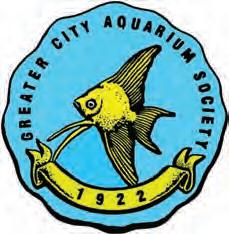May 2023
volume XXX number 3

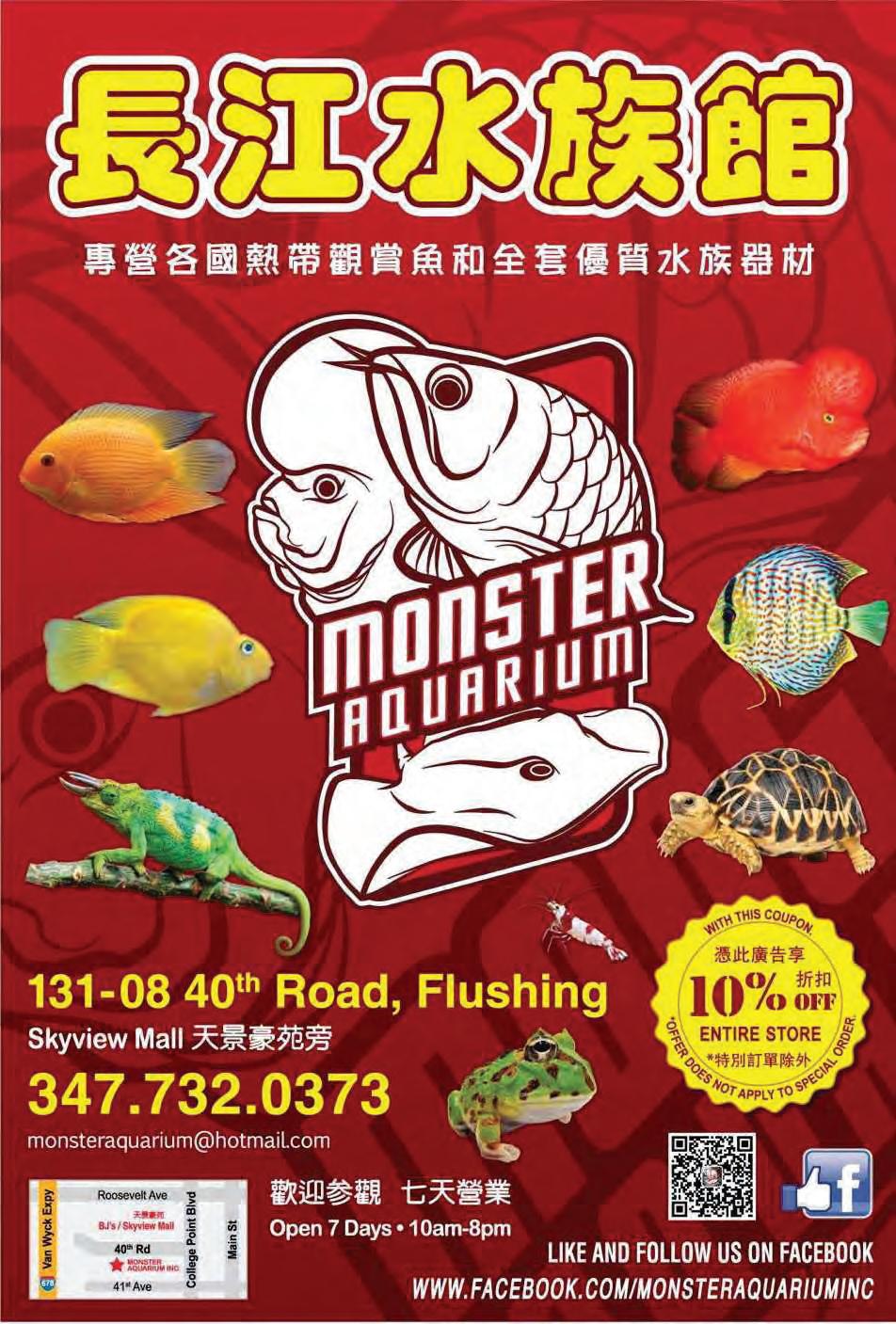
cover photo this month features a Green Dragon Bristlenose catfish (Ancistrus SP.).
photo is by Jan Sereni, who posted it on our Facebook Fishy Friends Phtotos page. Nice work, Jan!
GREATER CITY AQUARIUM SOCIETY
Bo ARD M EMB ERS
President Horst Gerber
Vice-President Edward Vukich
Treasurer Leonard Ramroop
Assistant Treasurer Open
Corresponding Secretary Open
President Emeritus Joseph Ferdenzi
M EMBERS AT L AR GE
Pete D’Orio Al Grusell
Jason Kerner Dan Radebaugh
Marsha Radebaugh
Co MM i TTEE Ch A i RS
Bowl Show Joseph F. Gurrado
Breeder Award........................Harry Faustmann
Early Arrivals Al Grusell
Membership Marsha Radebaugh
N.E.C. Delegate Joseph Ferdenzi
Programs....................................................Open
Social Media Gilberto Soriano
Technical Coordinator Jason Kerner
MODERN AQUARIUM
Editor in Chief Dan Radebaugh
Copy Editors:
Alexander A. Priest Susan Priest
Donna Sosna Sica Thomas Warns
Advertising Manager Robert Kolsky
See us on the Web:

In This Issue From The Editor 2 G.C.A.S. 2023 Program Schedule 3 President’s Message 4 Tonight’s Speaker: Emiliano Spada 5 Antique Aquariums and Equipment Fishy Friendsʼ Photos 6 April’s Caption Winner 7 Cartoon Caption Contest 8 by Denver Lettman When Was The First Aquarium Created? 9 by Thomas Warns New Yorkʼs First Aquarium Mega Store (Maybe) 13 by Joseph Ferdenzi Cover Photo Modern Aquarium June 1971 16 MA Classics by Don Sanford La Corte 17 MA Classics by Jan Padovani The NEC 2022 Articles Competition 18 The Origin of Modern Aquarium 19 MA Classics by Joseph Ferdenzi From The Editorʼs Desk 20 MA Classics by Warren Feuer Bowl Show Rules 21 Our Generous Sponsors and Advertisers 22 Walking . . . (Clarius batrachus) 23 by Derek P.S. Tustin Tales from the Tank 26 by Dan McKercher April Bowl Show Winners 26 Tall Tails & Myths 27 The Dobhar Chu by Dr. Glen Roberts G.C.A.S. Member Discounts 28 G.C.A.S. Classifieds 29 Modern Aquarium Covers 2012 30 MA Classics The Undergravel Reporter 31 How Low Can You Go? Fin Fun (Puzzle Page) 32 Countdown! Series III Vol. XXX, No. 3 May, 2023
The
ON THE COVER Our
From the Editor
by Dan Radebaugh
Whew! Here we are back again on a Wednesday evening! Don’t know why that seems to provoke such feelings of relief, but it does—at least for me. While last year we celebrated our 100th anniversary as an aquarium society, our magazine, Modern Aquarium, has a pretty nice history of its own. Please take a look at page 19 for Joe Ferdenzi’s account of the history of our magazine. This story was originally printed in the January issue of 1994, which was the first issue of what we now refer to as Series III of Modern Aquarium, which is what each of us Greater City members receives at each meeting. On the next page, Joe’s review is followed by Warren Feuer’s first “From the Editor’s Desk,” of which this present column is a descendent.
Fittingly enough, I was looking through a couple of old issues of Modern Aquarium (series II) that I had somehow not read yet, and found a couple of articles that I think are well worth sharing even at this late date. The first of these is an appreciation of Rosario LaCorte by Jan Padovani, which I found to be really nicely done, and I hope that you will enjoy reading it as much as I did. The second, a technical, illustrated look at how fishes breathe, will go unidentified for the present. Watch for it in our June issue.
It's been a little while since we've seen an article from Tom Warns, but he makes a big return! Be sure and see his article, “When Was The First Aquarium Created?” on page 9. Also in an historical vein (I love it when a plan comes together!) is Joe Ferdenzi's article, “New Yorkʼs First Aquarium Mega Store (Maybe)”. I have to say that I am stunned by the research that had to have gone into these two articles! Thanks, guys! May the Force stay with you!

Over the years weʼve presented several articles from Derek P.S. Tustin, including one that was submitted directly to us by Derek. This current article (see page 23) is about a fish that most of us will probably not come in contact with, as it is banned in the U.S. However, there are lots of them in Florida! Sold as food fish, the most common story there is that a truck transporting them along the Tamiami Trail went into a ditch and released enough of them to take over the southern part of the state. This may be literally true or not, but by now there are so many invasive species in that state that hardly anyone pays much attention any more. Ironically, this at a time when many native species there are under tremendous pressure due to habitat loss and climate change. But as Derek points out in his article, most of us here in New York are unlikely to encounter one of these “walking” catfish in the wild, and they get too big for most home aquaria.

By the way—the Undergravel Reporter column this month was inspired by a member suggestion. If you should have an idea that you think would make a good subject for Undie, by all means tell us about it!
Oh! Almost forgot! If you look at page 1 of this issue (the Contents page), you'll see a QR Code toward the bottom of the “blue” area. If you scan this with your cell phone it should take you straight to our Website! Thanks go to Jason Kerner for thinking of this and executing!
Modern Aquarium - Greater City A.S (NY) 2 May 2023
March 1
April 6
May 3
June 7
GCAS Programs 2023
Tom Keegan
Fish Biology 101, Part 1
David Banks
Lake Tanganyika Cichlids and Appropriate Tankmates
Emiliano Spada
Pre-Electric Aquarium Paraphenalia
Karen Randall
Sunken Gardens
July 5 Dr. Paul Loiselle
The World of Jewel Cichlids
August 2
September 6
October 4
November 1
Night At the Auction
Sebastian Alvarado
Color Changes In Fish
William Guo
Freshwater Shrimp
Tom Keegan
Fish Biology 101, Part 2
December 6 Holiday Party!
Articles submitted for consideration in Modern Aquarium (ISSN 2150-0940) must be received no later than the 10th day of the month prior to the month of publication. Please email submissions to gcas@earthlink.net, or fax to (347) 379-4984. Copyright 2023 by the Greater City Aquarium Society Inc., a not-for-profit New York State corporation. All rights reserved. Not-for-profit aquarium societies are hereby granted permission to reproduce articles and illustrations from this publication, unless the article indicates that the copyrights have been retained by the author, and provided reprints indicate source, and that two copies of the publication are sent to the Exchange Editor of this magazine (one copy if sent electronically). For online-only publications, copies may be sent via email to gcas@earthlink.net. Any other reproduction or commercial use of the material in this publication is prohibited without prior express written permission.
The Greater City Aquarium Society meets every month except January and February. Members receive notice of meetings in the mail or by email. For more information, contact: Dan Radebaugh at (718) 458-8437, email to gcas@earthlink.net, or fax to (347) 379-4984. For more information about our club or to see previous issues of Modern Aquarium, you can also go to our Internet Home Page at http://www.greatercity.net, http://www. greatercity.org, or http://www.greatercity.com.

Modern Aquarium - Greater City A.S (NY) May 2023 3
President’s Message
by Horst Gerber
Ican’t report much on our most recent meeting, since I couldn’t attend. I know what you are thinking, but no, I did not forget about the meeting date change to Thursday evening.
What does it mean to have an aquarium club that is considered top notch? There is an old line about the best aquarium club being the one you belong to. There is certainly some truth to this, but what have we done that has earned respect and praise from fish people? These are questions I asked at a recent board meeting. I believe that it starts with a club that becomes one with its members and grows with them, evoking a sense of family. Another part is that it provides a place where ideas and information are shared, creating an ongoing sense of belonging and mutual respect. Each member should be treated with respect, irrespective of how much or how little knowledge and experience they possess when they walk in the door. In the end, we’re all here to learn, and if possible to enjoy ourselves in the process. This can be from listening to our expert speakers, or from an interesting article in Modern Aquarium, or maybe just from chatting with other members who have similar interests in fish, or maybe even very different interests in fish! Either way, we still learn! Even our raffles and auctions are, or can be a learning experience. We have been fortunate in having a group of members who want to keep our club and meetings going during these Covid-plagued past few years. It has not been an easy or simple thing to do. Remote solutions, such as Zoom, have been a life-saver in keeping clubs going, and not just our own. A special thank-you goes to Jason Kerner, who really stepped up to the plate on this. All in all, as we pursue greater knowledge about the what and hows of our hobby, I just have to say “keep up the good work!”
By the way, I ve just learned that the LIAS will be holding its first meeting in over two years on Friday, May 19th at the AMVETS Hall Post 48 in Lake Ronkonkoma. This is only a little over a mile north of the expressway. The meeting will start at their usual eight o clock, but you should arrive earlier to settle in. Tom Keegan will be their new president. There will be a Basket Raffle with some nice larger items, and of course their regular raffle. Also a fish auction! They hope people will be bringing in fish that they have been breeding or that they want to auction to make room for new ones. We wish them the best of luck!

Horst

4 May 2023 Modern Aquarium - Greater City A.S (NY)
Emiliano Spada, Speaking on PreElectric Aquarium Paraphenalia.
Emiliano is an Italian collector of aquarium antiques, an author, a photographer, an aquarium designer, and a member of the advisory committee of the Museum of Aquarium and Pet History (San Luis Obispo, California).


Besides several aquariums, fish bowls and stands, ornaments, fish food tins, books, catalogs, magazines and ephemera, his stunning collection encompasses many paraphernalia of yesteryear such as air and water pumps, heaters, filters, hot air engines and lots of other items used by aquarists to keep fish.
During his presentation Emiliano will cover an overview of the paraphernalia from the pre-electric era, explaining how they worked despite the absence of electricity and how they helped the early generations of fishkeepers. His articles on aquarium history are posted monthly on moaph.org.

Modern Aquarium - Greater City A.S (NY) May 2023 5
Tonight’s Speaker: May 3, 2023
Emiliano’s illustration of an early aquarium advertisement showing one of the first heating systems, Thermocon, from Germany.
Fishy Friends’ Photos
by Greater City Aquarium Society Fishy Friends
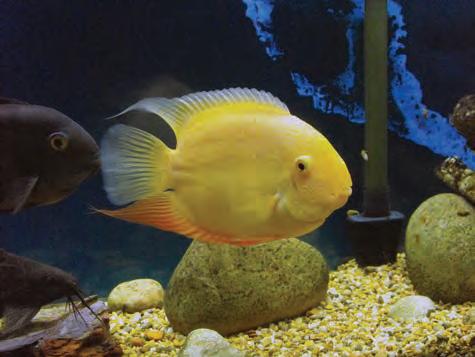




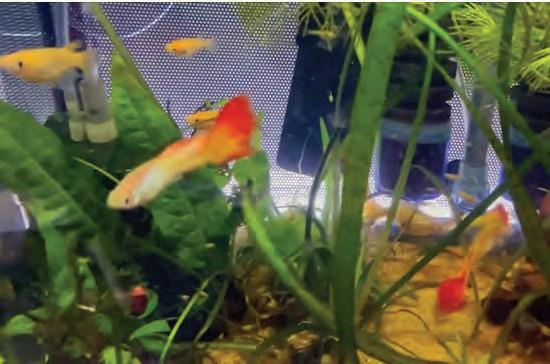

Below are photo submissions to our “Fishy Friends” Facebook group. I’ve left the subjects unnamed, but not the photographer. If you see a shot you like, and want more info, ask the photographer about it! I’m sure he or she will be delighted to tell you!

Modern Aquarium - Greater City A.S (NY) 6 May 2023
Joseph Gurrado
Nicki Bonds
Prasp Pasp
Dan Radebaugh
Victor Huang
Jules Birnbaum
Jan Sereni

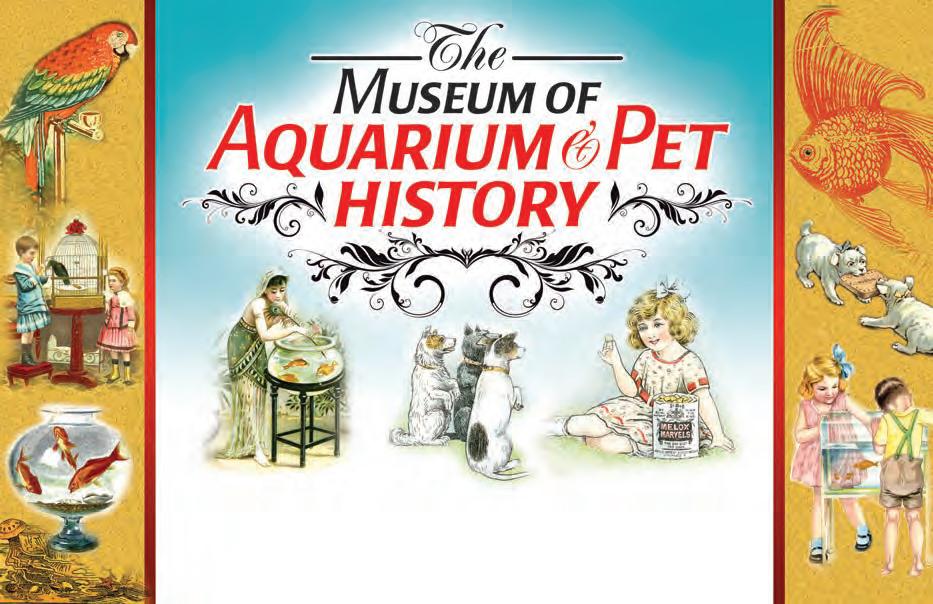
Modern Aquarium - Greater City A.S (NY) May 2023 7 April՚s Caption Winner: Matthew Jerry OʼFarrell I hope they don't Fishtail! If you like history, and you like pets, then this is the place for you. Dedicated to the history of aquarium & pet keeping, The Museum of Aquarium & Pet History includes a huge depository of over 3,000 items all focused on the pet industry. From antique fish bowls, aquariums and cages, to foods, medications, books and advertising signs, we’ve got it all! To learn more about this amazing collection of historical pet artifacts, please visit our website: moaph.org https://moaph.org/
The Modern Aquarium Cartoon Caption Contest

Modern Aquarium has featured cartoon contests before, and theyʼre back! You, the members of Greater City get to choose the caption! Just think of a good caption, then mail, email, or phone the Editor with your caption (phone:347-866-1107, fax: 877-299-0522, email: gcas@ earthlink.net. Your caption needs to reach the Editor by the third Wednesday of this month We'll also hand out copies of this page at the meeting, which you may turn in to Marsha or Dan before leaving. Winning captions will earn ten points in our Author Awards program, qualifying you for participation in our special ”Authors Only” raffle at our Holiday Party and Banquet. Put on your thinking caps!
Your Caption: Your Name:

Modern Aquarium - Greater City A.S (NY) 8 May 2023
https://www.amazonasmagazine.com/
When Was The First Aquarium Created? It Depends On How You Ask!
by Thomas Warns
It turns out that discerning precisely who made the first aquarium, and when, is more of a philosophical question than a historical one. Fishponds, both for aquacultural and ornamental purposes, have existed for thousands of years. Hieroglyphs and frescoes bear witness to the practice of wealthy Egyptians creating fish ponds in their gardens where they could raise fish until they were ready to be consumed. The Ancient Romans also kept fish ponds for ornamental and aquacultural purposes, calling them vivarium (literally, “place of life”), with eels apparently becoming quite popular.1 Some people trace the beginning of modern fishkeeping to the Jin Dynasty in China (265AD-420AD), when Chinese nobility first began selectively breeding carp into the goldfish that we know today.

Respectfully, however, none of these cultures produced an aquarium. All of the examples above involved viewing the fish from above, and almost always in a pond (artificial or otherwise). According to certain definitions, these may have been considered aquaria. Merriam-
Webster defines an aquarium as “a container (such as a glass tank) or an artificial pond in which living aquatic animals or plants are kept.” The Cambridge Dictionary similarly defines aquarium as “a glass container or pool in which small fish and other water animals and plants are kept.” Neither of these definitions is satisfactory, as an essential part of the hobby is the ability to view the fish from essentially within their habitat, eye-to-eye, and not from the top down.
“Colorless” glass of varying transparency had existed since before the birth of Jesus Christ, but it would take quite some time for someone (that we know of, anyway) to attempt to use it as a container for viewing fish. In the 1500s, the wife of French physician Guillaume Rondelet is reported to have kept a fish alive in a drinking glass for three years. Plate glass was first created in France during the 17th century, though it would take centuries for it to be applied to the aquarium hobby.
Indeed, by the second half of the 18th century, people had progressed to the point that
Modern Aquarium - Greater City A.S (NY) May 2023 9
Central Garden Pool in the Garden of Nebamun’s Tomb Painting, British Museum, late 18th Dynasty, circa 1350 BCE (Photo in public domain)
they kept goldfish in punch bowls, at least for limited periods of time. One early pioneer from the 1790s, Sir John Graham Dalyell, was known to collect and keep various invertebrate marine animals in jars. Sir Dalyell had a servant travel to the coast several times each week to collect seawater for water changes. One sea anemone he collected lived for almost sixty years in captivity. Nicknamed “Granny,” this sea anemone passed away thirty years after Sir Dalyell did, in 1887, and earned an obituary in numerous papers, including the New York Times.
None of the preceding examples can rightly be called an aquarium, however. The word aquarium was apparently first used by botanists, but adopted its present meaning thanks to English naturalist Philip Henry Gosse. Aquarium simply combined the Latin root aqua, meaning “water,” with the suffix -arium, meaning “a place for relating to.” Gosse sought a simpler term than aqua-vivarium, which was in use at the time. Gosse stated in his 1854 book, The Aquarium: An Unveiling of the Wonders of the Deep Sea, “let the word aquarium then be the one selected to indicate these interesting collections of aquatic animals and plants, distinguishing it as a Freshwater Aquarium, if its contents by fluviatile, or a Marine Aquarium, if it be such as I have
made the subject of the present volume.”
The decades prior to Gosse’s book adopting the term aquarium provide the first legitimate aquaria, though the precise answer is still up for debate. In 1829, Nathaniel Ward discovered that plants could be self-maintained in closed glass containers. “Wardian Cases,” as Ward’s glass containers for keeping plants came to be known, were a popular fad in the 1830s and 1840s, with ferns being the most popular plant to keep. In 1841, Nathaniel Ward was said to have first established a twenty-gallon freshwater protoaquarium, though it was in an “earthenware vessel.” Throughout the 1840s, Ward is said to have experimented with various home aquaria, which were more or less upside-down Wardian cases.
Other individuals experimented with marine proto-aquaria in that same time period. In 1842, Dr. George Johnston filled a glass jar with sea water and a number of organisms, including seaweed, corals, mussels, and a sea star. Dr. Johnston described how the organisms flourished for at least eight weeks. Another individual, Anna Thyne, experimented in 1847 with raising marine corals, sponges, and other small marine creatures in glass jars. Her corals and sponges lasted for several years. 1845 was a crucial year because

Modern Aquarium - Greater City A.S (NY) 10 May 2023
in that year, the glass tax that had been passed to fund the Napoleonic Wars decades earlier was finally repealed, which would shortly thereafter become a boon to the burgeoning aquarium hobby.
The turning point for the aquarium hobby came in 1850, when Robert Warington began his experiments into the “balanced” aquarium. While the concept of a “balanced” aquarium⸺i.e. one that was self-contained and stable for an indefinite period of time⸺was not Warington’s invention, Warington was certainly critical in taking the concept mainstream. Warington described his studies into the subject in great detail, earning him greater fame than either Dr. Johnston or Anna Thyne. Warington placed two small goldfish in a container with some Valisneria spiralis, theorizing that the aquatic plant would provide oxygen for the fish. When the decaying leaves of the Valisneria spiralis began to cloud the water, Warington responded by placing a few aquatic snails in the aquarium. Warington thus created a stable ecosystem where the aquatic plant provided oxygen for the fish and food (decaying leaves) for the snail, the snail broke down the decaying plant leaves, and the fish ate the eggs and offspring of the snails.


created intense interest among the public in raising fish in one’s own parlor room, and developing the right vessel for such an endeavor began in earnest. Warington’s fish tanks were typically made of slate, with a front pane of glass, and a sloped back. The panes of glass and slabs of slate were held together with steel. The sloped back and slate exterior was said to have moderated the
effect of the sun and heat on the aquarium water, and was also said to have lent great strength to the tank.
By the 1850s, so-called “Warrington Cases,”3 appear to have proliferated. Gosse criticized the slope back design, finding that it made the tank far too dim to observe the fish. Gosse instead encouraged the development of aquaria with glass on all sides, often with interesting adornments on the corners. By 1853, the London Zoo is said to have had multiple aquaria with glass on all sides based on Gosse’s commentary, and by 1856 another naturalist named Shirley Hibberd published a book with illustrations of private homes containing all-glass aquaria.
Where does that leave us? The Warrington cases appear to be, by all accounts, the first true aquarium⸺it was a purpose-built container filled with water to house fish, with at least one transparent side that allowed the fish to be viewed from the side, and it provided the fish with a stable environment it could live in indefinitely. Gosse deserves credit for creating and championing aquaria with glass on all sides, which has been adopted universally in modern fish tanks and provides a superior viewing experience. I do not cast judgment on those who say that Dr. Johnston and Anna Thyne built the first aquaria, but I myself cannot agree. Dr. Johnston and Mrs. Thyne merely placed fish into glasses and jars, but those vessels were not purpose-built specifically for keeping fish. Their contributions to the aquarium hobby, however, like the contributions of everyone mentioned in this article, are worth remembering and appreciating.
Four different styles of “Wardian cases.”
Notes:
1. To read more about fishkeeping in Ancient Rome, please read my article from April 2019, titled “A Brief History of the World (of Ancient Roman Fishkeeping).”
Modern Aquarium - Greater City A.S (NY) May 2023
2. The “balanced aquarium” would turn out to be something of a myth. Almost one hundred years later, Dr. Charles M. Breder, Jr., an ichthyologist and aquarium hobbyist, actually measured the carbon dioxide and oxygen in aquarium water and discovered that the amount of oxygen produced by plants is actually quite miniscule, and that aquarium water is saturated with oxygen because of the rapid transfer of oxygen at the air-water boundary. Still, Warington (and Gosse) deserve tremendous credit for their scientific approach to the aquarium hobby, and for publishing their studies in order to further the hobby and increase public interest.

3. Aquaria of various designs in the 1850s were marketed as Warrington cases, likely to play on the popularity of Wardian cases that already adorned the parlours of many Victorian homes. Though named after Robert Warington, the glass aquarium was popularly known as a Warrington Case.
4. Endnotes: Much of this article is sourced from two publications. The first is Klee, Albert, The Toy Fish: A History of the Aquarium Hobby in America - the First One-Hundred Years, Revised and Expanded Edition (Finley Aquatic Books, 2003). The second is Kisling, Vernon, Zoo and Aquarium History: Ancient Animal Collections To Zoological Gardens, First Edition (CRC Press, 2000).

Modern Aquarium - Greater City A.S (NY) 12 May 2023
New York’s First Aquarium Mega Store (Maybe)
by Joseph Ferdenzi President Emeritus, Greater City Aquarium Society
Those of us who have been in the aquarium hobby for awhile usually have fond memories of some pet shop from our youth that no longer exists. In New York City those remembrances often center on shops in the borough where we grew up. In my case that was Queens, so I recall Cameo Pet Shop in Richmond Hill, Coral Aquarium in Jackson Heights, Coral Gables Pet Shop in Corona, and Ed’s Aquarium in Forest Hills. Of course regardless of which borough you lived in, almost everyone was familiar with the nationally famous Aquarium Stock Company in Manhattan. Unfortunately, all these great stores are gone, as are most likely any stores in the borough where you grew up. But I dare say that no one now living remembers the aquarium store that is the subject of this article, which was probably one of New York City’s very first aquarium stores: William Stoffregn of Manhattan.
My interest in this store was aroused by the fact that I own a very rare piece of ephemera: a four page handbill advertising the Stoffregn store. Unfortunately, there are no dates on this small brochure, but given the typeface and style, and the fact that in its discussion of the “selfsustaining” aquarium, no mention is made of any tropical fish other than the Paradise Fish, I would estimate that it was printed before 1910. By contrast, various sources give the establishment of the Aquarium Stock Company as either 1910 or 1912.
Thinking that you will find this brochure to be very interesting reading, we are reprinting here in full the first three pages (the fourth page is dedicated to birds and bird supplies). Note how on the first page the store heralds itself as “The Largest Establishment of the kind in the United States.” Is that mere hyperbole? Further research discloses that it may not be.
Let’s start with the fact that this store was around before many others and that it was located in Manhattan at a time when all the biggest and most famous emporiums were located there. The earliest printed reference that I could find for this store dates back to 1899.
It is in a journal entitled “Proceedings of the Board of Trustees of the College of the City of New York.” The journal contains a list of purchases and expenses, and included among these is an entry for an “Aquarium” purchased from Stoffregn at a cost of $38. Since $1 back then is roughly equivalent to $36 in 2023, that means the aquarium cost them $1,368 in today’s dollars! That must have been one huge and elaborate aquarium! The fact that it was purchased from Stoffregn is an indication that it was the preeminent aquarium store of the time and might have indeed lived up to its boast of being “The Largest Establishment of the Kind in the United States.”
Another indication of Stoffregn’s preeminence as a pet shop is to be found in a U.S. Senate report from 1922. The report was focused on the cost of imported goods as compared to their retail sale price in the U.S. One of the goods listed is a wire bird cage from William Stoffregn of 124 Fourth Avenue (the same location as on the handbill). The reason

Modern Aquarium - Greater City A.S (NY) May 2023 13
this is significant is because a perusal of many of the goods purchased for this report reveals they were from the landmark stores located in Manhattan, such as Macy’s, Bloomingdale’s, Gimbel’s, and so forth. So it seems the Senate staffers went to stores that were well known in the field (of course they could not have purchased
a bird cage from the Aquarium Stock Company, although a well-known store by 1922, because it dealt solely in aquariums and fish).
This Senate report establishes that Stoffregn was still in business in 1922, which would show that it was operating for over two decades, and probably at the same address. Additionally, at some point Stoffregn offered a catalog of aquarium fishes and supplies. This is documented by a letter dated November 10, 1914 in the collection of the Schenectady County (NY) Historical Society. It’s a letter from Charles Steinmetz (a renowned scientist and professor at Union College in Schenectady) requesting the catalog from Stoffregn.

Another interesting fact about Stoffregn is that they apparently did not believe in advertising in aquarium magazines. After examining numerous issues from the 1910’s 20’s, and 30’s, I have been unable to locate even one advertisement. This is especially curious given that when the city-owned New York Aquarium published one of its very first official guides in 1901 (the aquarium was founded in 1896), Stoffregn had a prominent full-page ad on the inside front cover (see illustration). Like the handbill, it touts itself as “The Largest Establishment Of The Kind In The United States.” Moreover, I did locate a small ad for Stoffregn in a 1920 issue of a magazine called The Guide To Nature, which notes they ship livestock, but “entirely at the buyer’s risk.” And, in a sign of the times, they also tout that they have a telephone! So they did advertise, but for reasons unknown, not in aquarium magazines. Maybe they thought their low circulation numbers did not justify the expense? Thanks to my friend Lee Finley, I have a photocopy of one of their early catalogs. It is approximately 9 X 6 inches, and consists of 12 pages. The selection of tanks and bowls is quite extensive, but the fish not much so. See illustrations of a few sample pages.
I do not know what happened to their establishment after 1922. Did it go under during the aftermath of the great stock market crash of 1929? I do not have the answers, but from what I have gathered, I believe that the Stoffregn store once again reaffirms New York City as the most important center for the aquarium hobby that arose during the 19th Century's "Gilded Age."

Modern Aquarium - Greater City A.S (NY) 14 May 2023





Modern Aquarium - Greater City A.S (NY) May 2023 15

Modern Aquarium - Greater City A.S (NY) 16 May 2023
MA Classics
Cover photo of Pseudotropheus zebra pair by Don Sanford
By Gian Padovani, LIAS
During the years, as I became more involved in the tropical fish hobby, I became conscious of a name that, because of the frequency in which it appeared in publications and because of its musical sound, left an indelible mark in my mind: Rosario LaCorte.

I finally got an opportunity to meet this legendary man when a mutual friend, John Cillo, himself a breeder and hobbyist of considerable note, agreed to introduce us. It was with no little expectation and excitement, at least on my part, that we drove to Elizabeth, New Jersey, to Rosario’s home. We found him busily at work in his enlarged two car garage, which is his fish room.
After the introductions, he proceeded to show us the neatly arranged setup. At once it became apparent to me that this setup was different. It wasn’t larger or more elaborate than others I had seen; rather it reminded me more of an exotic aquarium shop. That is, because instead of seeing one species in all of its growing stages, many different species were present. However these were species that were hardly ever seen by the average hobbyist, and Rosario was already in the process of breeding them. Being the dedicated man that he is, LaCorte has had many firsts, but he is more interested in success itself, rather than to have the success acknowledged or publicized.
He has disproved the common theory that wild Discus cannot be bred in captivity. He is currently raising a strain, developed from his own wild stock, so beautiful that it is impossible to describe. I was impressed when I first confronted the Wattley strain. I could only gasp when I saw Rosario’s development, sporting dazzling, almost electric colors, these young discus swam with fins almost locked in erect position. I thought that I was familiar with most of the new imports from Lakes Malawi and Tanganyika. Rosario has cichlids from these exotic places which I had never seen (some as yet unnamed). The amazing thing is that some of them are already swimming amidst their fry.
Although I was impressed by his fish, I wanted to find out more about the man behind the success, and though we had met only a short while ago, a few characteristics soon became apparent. Rosario LaCorte is more of a scientist than a breeder. He will explore and experiment with the determination and dedication exhibited only by few persons. He is not interested in making money with his fish; whatever he sells is surplus or has served its purpose. He is a quiet, intense man who doesn’t herald or brag about his accomplishments, and it seems strange to me that fishes have been named after collectors, and none “……… LaCortei” to honor a man who has contributed so much to science and the hobby.
When I asked him for the secret of his success, he jokingly answered, “because I am a stubborn Sicilian...” His wife Jeannie however, summarized the true answer. Since he
Modern Aquarium - Greater City A.S (NY) May 2023 17 MA Classics
This article is reprinted from the June 1971 issue of Modern Aquarium
was a little boy, Rosario has thought, dreamed, and lived FISH. This interest continues even after the fish have died. In a corner of his fish room, which is more like a laboratory, one can see a powerful microscope and dissecting tools used to probe for unanswered questions.
Rosario LaCorte is a man of many talents. Aside from the obvious, he is an accomplished writer with many articles to his credit. He has taken excellent photographs of his fishes, which he uses in his not too frequent lectures and to illustrate his articles. Last but not least, he dabs in oils and pen and ink.
His family adores him and the feeling is reciprocal. His wife is a warm, friendly woman, with the bubbly personality that complements Rosario’s reservedness. When it came time to part, I felt very elated in the knowledge that my life has been enriched with the meeting of Rosario LaCorte.
The NEC 2022 Articles Competition
OPEN CATEGORY
1. My Life With Fish - Science ProjectsJason
2. Dehumidifier Or Air Exchanger?
3. Some Tricks From My Fishroom
BREEDING CATEGORY
1. Breeding Fundulopanchax amieti
2. Breeding Nothobranchius guentheri
3. Breeding Girardinnus metallicus
HUMOR
1. Cartoon Caption Contest
2. None submitted 3. None submitted
CONTINUING COLUMNS
1. The Undergravel Reporter
2. The Traveling Aquarist
3. FIN FUN (Puzzle Page)
JUNIOR AUTHOR
1. None
2. None
3. None
*Greater City Aquarium Society **Aquarium Club of Lancaster County


Modern Aquarium - Greater City A.S (NY) 18 May 2023
Gold Modern Aquarium GCAS*
Dan McKercher Modern Aquarium GCAS*
Jules Birnbaum Modern Aquarium GCAS*
Joel Antkowiak Tank Tales ACLC**
Joseph Ferdenzi Modern Aquarium GCAS*
Dan Radebaugh Modern Aquarium GCAS*
Denver Lettman Modern Aquarium GCAS*
The Undergravel ReporterModern Aquarium GCAS*
Joel Antkowiak Tank Tales ACLC**
Modern Aquarium GCAS*

Modern Aquarium - Greater City A.S (NY) May 2023 19 MA Classics This article is reprinted from the January1994 issue of Modern Aquarium -Series III number 1.

Modern Aquarium - Greater City A.S (NY) 20 May 2023
There is a Bowl Show at every GCAS meeting, except our Night at the Auction/ fleamarket meeting and our Holiday Party and Awards Banquet meeting. Bowl shows are open to all members of GCAS. Rules are as follows:
• Only current GCAS members may enter fish in the Bowl Show.
• There is a limit of 2 entries per member per meeting.
• Unlike some other clubs, every month is an “open” Bowl Show at the GCAS (i.e., there is no “theme,” such as that one month cichlids are judged, the next livebearers, the next anabantoids, etc.).
• Any fish that wins any prize (1st, 2nd, or 3rd) may not be entered again in the same meeting year.
• B.Y.O.B. (Bring Your Own Bowl!) Entrants are responsible for providing suitable containers and suitable water for their fish. These containers must be clear on at least three sides.

• Only one fish per container (i.e., no “pairs”).
• No plants, ornaments, or equipment (filters, airstones, etc.) are allowed in the judging tank (an external mirror, or opaque cards between containers is acceptable, as is a cover that does not obstruct side viewing).
• Points are awarded: 5 points for 1st Place, 3 for 2nd Place, and 1 for 3rd Place.
• Ribbons are awarded: blue for 1st Place, red for 2nd Place, and green for 3rd Place.
• The person with the most points at the end of the meeting season receives the Walter Hubel Bowl Show Champion trophy at the Awards Banquet.
• The decision of the judge(s) is final.
• A running UNOFFICIAL total of the points awarded is printed in Modern Aquarium. Only the tally of points maintained by the Bowl Show Coordinator is official.
• In case of ties:
• 1st Tiebreaker – most 1st Places
• 2nd Tiebreaker – most 2nd Places
• 3rd Tiebreaker – most entries
Modern Aquarium - Greater City A.S (NY) May 2023 21 Modern Aquarium - Greater City A.S (NY) Futures-A 9
Advanced Marine Aquatics
Al’s Aquatic Services, Inc.

Amazonas Magazine
Aquarium Pharmaceuticals
Aquarium Technology Inc.
Aqueon
Brine Shrimp Direct
Carib Sea
Cobalt Aquatics
Coralife
Ecological Laboratories
Fishworld
Florida Aquatic Nurseries
Franklin Pet Center Inc
Fritz Aquatics
HBH Pet Products
High Quality Exotic Goldfish
Hydor USA
Jehmco
Jungle Bob Enterprises
Jungle Labs
Kent Marine
KHC Aquarium
Kissena Aquarium
Marineland
Microbe Lift
ModernAquarium.com
Monster Aquarium, Inc.
Nature’s Reef & Reptile
NorthFin Premium Fish Food
Ocean Nutrition America
Oceanic
Omega Sea
Pacific Aquarium, Inc.
Penn Plax
Pets Warehouse
Pet Resources
Pisces Pro
Red Sea
Rena
Rolf C. Hagen
San Francisco Bay Brand
Seachem
Sera
Spectrum Brands
Your Fish Stuff.com
Zilla
Zoo Med Laboratories Inc.
Modern Aquarium - Greater City A.S (NY) 22 May 2023
by Derek P.S. Tustin
One of the things that I’ve come to realize over my years of being involved in this hobby is that if you don’t make mistakes, you never learn. Sometimes it is with a great deal of embarrassment that I admit to having done some of the things I have done, and one of the most embarrassing was trying to keep Clarias batrachus, the Walking Catfish.
The year after I joined DRAS, I lost the companionship of Nikki, my Black Lab / Dalmatian cross that I had since my years in university. She was a great dog, and I could go on and on for hours about the memories I have of her, but one of the two funniest I have of her involved a Walking Catfish. While a student at the University of Windsor, I had traded for a 190 litre (55 gallon) aquarium, and it was my first true large aquarium. Prior to that I had several small tanks, each about 20 litres (5 gallons) and each had been stuffed with fish. When I upgraded, I went slightly crazy and, after placing the inhabitants of my various other tanks in, purchased almost everything that caught my interest and that I could afford to full up the big tank. One of these fish was a piebald Walking Catfish. Now in those early days of my involvement with the hobby I didn’t know much about water changes and proper maintenance. My idea of cleaning was to drain the tank, place the fish in buckets and scrub almost everything. The first time I did this after getting the Walking Catfish, I was in the process of re-filling the aquarium, filling and carrying buckets up from the downstairs bathroom, when Nikki, who was still upstairs, started a frenzied barking. I ran up the stairs to see what was wrong, and as I got to the top I saw Nikki crouched, her ruff up, barking at… the Walking Catfish flopping across the carpet towards her. You see, I hadn’t covered the bucket and fish had obviously jumped out. I scrambled around trying, but not succeeding, to pick up the fish and every time I almost had it, the fish squirmed out of my grasp, heading each and every time towards Nikki, who continued to bark at this strange creature seemingly intent on reaching her. After about five minutes, I managed to get the Walking Catfish back into the bucket, throwing a towel over the top. But from that day on, I don’t think poor Nikki ever trusted that anything good would come out of that aquarium.
In retrospect, I should have done a lot more research before I even considered purchasing the fish, but the local aquarium stores weren’t all that helpful or knowledgeable. Windsor didn’t (and still doesn’t) have an aquarium society, and the boundless knowledge of the internet was not yet common. Detroit, for all its physical proximity, remained a foreign land, and I knew nothing about the clubs that I now know have been there for decades. So maybe my error is forgivable, but for those who aren’t familiar with this fish that I will always remember with a smile, let me tell you a bit about it.
The Walking Catfish, Clarias batrachus, is native to South East Asia, being found in India, Sri Lanka, Pakistan, Thailand, Vietnam, Cambodia, Malaysia, and Indonesia amongst others in the region, and has also been introduced, both accidentally and intentionally, to other countries around the world. In its native range, the Walking Catfish is a valuable food fish, and is extensively utilized by both subsistence and commercial fisheries.


Modern Aquarium - Greater City A.S (NY) May 2023 23
This article is reprinted from the Durham Region Aquarium Societyʼs Tank Talk –May 2013 / Volume 40, Number 09
The fish now known as Clarias batrachus was first described by Carolus Linnaeus in 1758 as Silurus batrachus, with the current genus name of Clarias, derived from the Latin for “shining”, being erected by Johannes Scoploi in 1777. It belongs to the family of fish known as Clariidae, which encompass 84 species across 15 genera. The genus Clarias is by far the largest in the family, with 34 species.
In terms of body shape, the fish has a broad and flat head that then tapers to the tail, calling to mind the shape of a tadpole’s body. It has small eyes, a broad mouth (which cannot actually open very wide) and four pairs of barbels arranged around the snout. The dorsal and anal fins are long, terminating before the caudal fin, and the pectoral fins are very rigid. It is also able process oxygen through its gills. Unlike many other species of fish, the gills are actually supported by a special organ, and as a result when out of water, the gills, unlike those fish lacking the support for the gills, can still absorb oxygen directly from the air. The body is actually quite powerful, and the Walking Catfish is able to laterally flex its body back and forth. It is through the flexation of the body and the support of the body on the stiff pectoral fins that the fish is able to “walk” on land, and it can successfully do so utilizing the special gill organs to continue to process oxygen while out of water.
But why walking? In nature, it is known to inhabit lakes and rivers, but is more commonly found in areas where water can be intermittent. Such areas include muddy ponds, canals, ditches, swamps… basically areas where water can be present at one time and absent at another. Once the water disappears from a given location, the fish possesses the ability to locomote and continue to breathe until it reaches another body of water. The only limitation to its movement is the necessity for the skin to be kept moist.
There are three main variations of the Walking Catfish that are available to the aquarium hobbyist; the standard or natural strain, the piebald strain and the albino strain. The natural strain is usually a uniform brown-gray or gray colouration, with a light grey ventral surface, and has many small white spots along the lateral surfaces. The piebald strain, sometimes referred to as the calico strain, has a pinkish body and brownish coloured spots, similar in colour to the natural strain, scattered across the body. The third strain, the albino, has a pink body with red eyes. The latter two are by far the more commonly available in aquarium stories, probably due to their different appearance.

Due to its sheer tenacity, ability to survive, and its predatory nature, it has become an invasive species in many parts of the world. The website Environmental Graffiti lists it as #7 on the 12 Worst Invasive Fish on Earth (www.environmentalgraffiti.com/news-invasive-fish?image=7). In the United States it has become a significant invasive species, most notably in Florida, and all members of the Clariidae family are actually illegal to possess anywhere in the United States without a federal permit.
In Canada they are not deemed to be an invasive species, and likely will not be deemed one, given their inability to survive temperatures below 9.5oC (50oF). As such, they remain occasionally available for sale in aquarium stores, with the piebald and albino strains being most often seen. If keeping this fish, a large tank is recommended, with a soft substrate and decorations such as driftwood or smooth rocks placed to create hiding spaces. As I (and Nikki) discovered, the fish is an excellent jumper, and a tight fitting cover is a necessity. The fish is also known to occasionally gulp air from the surface of the aquarium, and seeing the fish do so should not cause undue concern.
They are greedy fish, eating everything that is offered, and as they grow, they will show no hesitation in eating smaller tank-mates. A varied diet of both meaty food and vegetable matter is recommended, but it should be noted that they will eat as long as food is provided, so it is very easy to overfeed. They also do not need to be fed every day.
Given their ability to survive, it is perhaps not surprising that given the proper environment they are actually very easy to breed. If you are trying to do so, it is recommended that you either obtain
Modern Aquarium - Greater City A.S (NY) 24 May 2023
a sexed pair, or begin with a small group of these fish in order to ensure that you have one of each gender. Once they reach sexual maturity, usually when the reach 30 cm (12") in size, and assuming you have one of each gender, a pair will be formed. Sexing of the fish is determined by examination of the genital papillae, with the male’s being longer and pointed. The female may also appear rounder in the belly. Once the pair is formed, they will become very territorial, attacking any other fish in the area. All other fish, including any other Clarias batrachus should be removed from the breeding tank, leaving the pair alone.
The pair will begin to swim side-by-side, with increased body contact. In nature, they would dig a cave in a riverbank, but in the aquarium they will substitute this by digging a pit in the substrate, where the eggs will be deposited. Over a period lasting almost a day, the pair will mate above the nest several times, producing as many as several thousand eggs. These eggs are negatively buoyant and will sink to the substrate, adhering where they fall.

After depositing the eggs, the female will retreat, and the male will begin to guard, swimming above the nest. After a period of 24 to 36 hours, the eggs will hatch, and the female will also start to engage in care, guarding the perimeter of the pair’s territory, while the male continues to guard the area immediately above the nest.
For another two days the parents continue their sentinel duty, but then will begin to loss interest. After another three days, the fry will become free swimming, and should you be interested in rearing the fish, it is recommended you remove the fry to another tank, where small foods such as brine shrimp can initially be offered. The fry will apparently grow very quickly, soon reaching the point where bigger foods can be provided.
In many ways it is a shame that the size and legality issues make the keeping of Clarias batrachus problematic, because it truly is an interesting and fascinating fish that has the capacity to expand the horizons of an aquarist.



Modern Aquarium - Greater City A.S (NY) May 2023 25
Tales from the Tank
by Dan McKercher
Sam complains to the shopkeeper that his fish keep dying soon after he puts them in his tank. The shopkeeper says, “Bring in a water sample.” Sam has a blank look and then replies, “Nobody said anything about water...”


Police blotter: Two men are arrested for fist fighting over whose fish is better looking, while 6-year old Betty walks away with 1st place at the show.
Did you ever…
Look into one of your tanks and say, “who are you?”
Drop something on the floor and think “I should pick that up,” only to trip over it a moment later?
Have a fish jump out of the net and disappear until next week?
Testing the water: Put an empty tank with rack in the bedroom just to see what happens?
Is it better to ask for forgiveness than for permission when buying another tank?

April Bowl Show Winners
Modern Aquarium - Greater City A.S (NY) 26 May 2023
1st Place
Nothobranchius
2nd Place Richard Waizman (Silver Plakat Betta) 3rd Place John Buzzetti ⸺ (Betta splendens)
John Buzzetti
rachovii (Killi)
Tall Tales & Myths
The Dobhar Chu
by Dr. Glen Roberts
Irish folklore is littered with horrendous water creatures. One of the more frightening is the Dobhar Chu (pronounced do-war coo). The Dobhar Chu is thought to inhabit lakes of the British Isles and is Ireland’s version of Nessie, although not as big. Dobhar Chu is only about 7 feet long and looks part dog and part otter. In fact, Dobhar Dhu is an ancient word meaning otter.


Commonly called the water hound or the hound of the deep, this creature is bloodthirsty and likes human flesh. Legend tells of there being two of these creatures in any one place. If one is killed, the partner will race to the surface and devour the killer! This creature is known for its fantastic speed, so out running an angry Dobhar Chu is unlikely.
More than just a myth, the Dobhar Chu is referred to as a cryptid. This puts it in the same category as Nessie and Bigfoot. Many people believe that have actually seen the hound of the deep. Sightings of the Dobhar Chu have been reported as recently as 2000. There even is a 16th century tombstone in Cornwall that depicts this creature as connected to the death of the woman buried there. She was washing her clothes in the lake when her husband heard her scream. When he arrived at the shore, she was dead and the Dobhar Chu was feasting on her body. Of course he killed the creature, but as it died it let out an ear-piercing
whistle that called its mate. Apparently, in this case, the man killed the second creature also. Lesson learned here? Don’t wash you clothes in the lake unless you’re prepared to tackle the Dobhar Chu!

Modern Aquarium - Greater City A.S (NY) May 2023 27
Reprinted from The Kitchener-Waterloo Aquarium Society’s Fins & Tales , Volume 58 Issue 4April, 2019
GCAS Member Discounts at Local Fish Shops



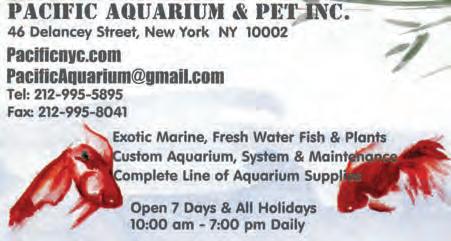




Modern Aquarium - Greater City A.S (NY) 28 May 2023 10% Discount on everything except ʽon saleʼ items. 20% Discount on fish. 15% on all else. 10% Discount on everything. 10% Discount on everything. 10% Discount on everything. 10% Discount on fish. 10% Discount on everything.
10% Discount on everything.
10% Discount on everything.
10% Discount on everything.
10% Discount on everything.
15% Discount on everything in store, or online at: http://www.junglebobaquatics.com Use coupon code gcas15.



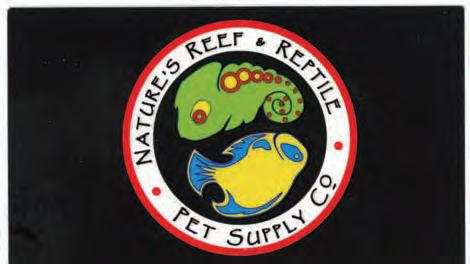



Modern Aquarium - Greater City A.S (NY) May 2023 29
Modern Aquarium Covers 2012



March 2012 Exotic Aquarium Fishes by Steven Hinshaw








April 2012 Betta rubra by Alexander A. Priest
May 2012 Holacanthus tricolor by Stephen Sica
June 2012 Parosphromenus deissneri by Alexander A. Priest
July 2012 Austroloheros Sp. "red ceibal." by Alexandra Horton
August 2012 Sphaerichthys selatanensis by Alexander A. Priest
September 2012 New York Aquarium COPA NY ZOOLOGICAL SOCIETY
October 2012 Betta uberis by Alexander A. Priest
November 2012 Betta balunga by Alexander A. Priest
December 2012 Cardina cf. cantonensis Sp. Tiger by Wallace Deng
Modern Aquarium - Greater City A.S (NY) 30 May 2023
In spite of popular demand to the contrary, this humor and information column continues. As usual, it does NOT necessarily represent the opinions of the Editor, or of the Greater City Aquarium Society.

A series by the Undergravel Reporter
Days after the new snailfish was filmed, scientists caught two other snailfish from species Pseudoliparis belyaevi in the trench at 26,318 feet. Researchers report that these fish are the first to have ever been collected from a depth greater than 8,000 meters — or 26,246 feet.
The species found near the ocean floor have adapted over eons to survive more than 1,000 meters deeper than the next known deep-sea fish, according to Prof. Alan Jamieson, the expedition’s chief scientist and founder of the Minderoo-UWA Deep Sea Research Centre.
According to an article in the New York Post, “a fish has been captured by researchers swimming at never-before-recorded depths of over five miles below the ocean’s surface off the coast of Japan.”1
The unknown species of snailfish (belonging to the genus Pseudoliparis) was caught on camera swimming 27,350 feet underwater by a deep ocean vessel in the Izu-Ogasawara trench, south-east of Japan.

Reference:
Jamieson noted that, “One of the reasons [snailfish] are so successful is they don’t have swim bladders,” he continued. “Trying to maintain a gas cavity is very difficult at high pressure.” They do not have scales, but have a gelatinous layer around their bodies that Jamieson called a “physiologically inexpensive adaptation.”
https://nypost.com/2023/04/04/researchers-find-fish-swimming-5-miles-below-the-surface/?dicbo=v2-mJ0tX78

Modern Aquarium - Greater City A.S (NY) May 2023 31
Modern Aquarium - Greater City A.S. (NY) May 2023 17
Fin Fun
Match the scientific names with their common names for the “numbered” fish below:
Onespot betta Ginsburgellus novemlineatus
Twospot rasbora Thalassoma hardwicke
Threespot gourami Hyporthodus exsul
Four-eyes Chaetodon punctatofasciatus
Fiveband barb Trichopodus trichopterus
Sixbar wrasse Rasbora elegans
Sevenband butterflyfish Chaetodon octofasciatus
Eight-striped butterflyfish Desmopuntius pentazona
Ninelined goby Betta unimaculata
Tenspine grouper Anableps anableps
Source: Fishbase.org
Solution to our last puzzle:
Rice fish Oryzias latipes
Licorice gourami Parosphromenus deissneri


Chocolate gourami Sphaerichthys osphromenoides
Peppermint goby Coryphopterus lipernes
Honey gourami Trichogaster chuna
Jellybean tetra Lepidarchus adonis
Coffee-bean tetra Hyphessobrycon takasei
Cherry barb Puntius titteya
Strawberry darter Etheostoma fragi
Candy darter
Cinnamon killi
Solution to our last puzzle:
Etheostoma osburni
Fundulopanchax cinnamomeus
Modern Aquarium - Greater City A.S (NY) 32 May 2023
24 May 2023 Modern Aquarium - Greater City A.S. (NY)

